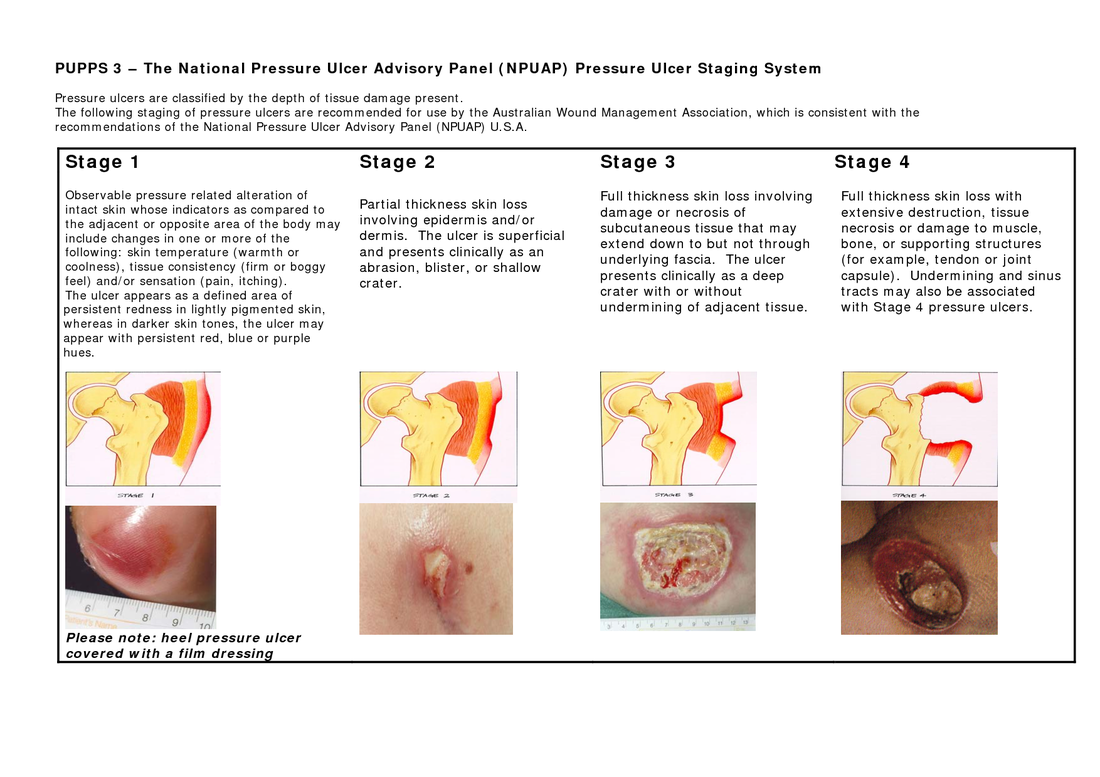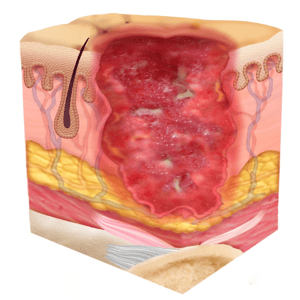A Stage 3 Pressure Ulcer Involves Which of the Following
From the final and more. A stage 1 pressure ulcer involves which of the following.

National Pressure Ulcer Advisory Panel Pressure Ulcer Stages A Staging Download Scientific Diagram
In this article 1.
. 6 rows Stage III. Indications Stage 3 involves the full thickness of the skin and may extend into the subcutaneous tissue layer. Stage 1 or 2 pressure ulcers Skin tears Moisture associated skin damage MASD of the incontinence-associated dermatitis IAD type Contact dermatitis Friction blisters.
Sutured surgical incision C. Varies by anatomical location. Stage 3 bedsores are quite deep but tendons ligaments muscles andor bones will not be visible.
If the medical documentation supports active bleeding of a gastric ulcer the physician must identify. Question 1 25 out of 25 points A stage 3 pressure ulcer involves which of the following. A pressure ulcer is a localized injury to the skin or underlying tissue usually over a bony prominence as a result of unrelieved pressure.
The prevalence of pressure ulcer increased in the years following the injury NSCISC 2021 Fig. Stage 4 pressure wounds and ulcers. A medical professional relies on a bedsores appearance to diagnose its stage.
The nursing instructor is reviewing the wound healing process with a group of nursing students. Rewrite the following arguments using letters to represent the terms reduce the number of terms and put the arguments into standard form. Casted bone fracture D.
The bridge of the nose ear occiput and malleolus do not have adipose subcutaneous tissue and stage III ulcers can be shallow. May extend down to but NOT through underlying fascia. Laceration sealed with adhesive.
Bonetendon is. Stage 3 involves the full thickness of the skin and may extend into the subcutaneous tissue layer. The NPUAP guidelines define a Stage 2 pressure injury as the following.
Question 20 18 out of 18 points For hemorrhage to be reported there does not have to be active bleeding. Full thickness skin loss involving damage or necrosis of subcutaneous tissue that may. Full thickness skin loss involving damage or necrosis of subcutaneous tissue that may extend to but not through the underlying fascia.
A Stage 3 pressure ulcer involves full thickness tissue loss including the epidermis and the dermis. The spinal cord injury population is at great risk for pressure injuries. Stage 3 pressure ulcer B.
The ulcer appears as a deep crater with or without undermining of adjacent tissue. However there must be documentation in the medical record indicating active bleeding has occurred andthe. A stage 3 pressure ulcer involves which of the following.
Granulation tissue are often present. Involves damage to or necrosis of subcutaneous tissue. According to the NPUAP guidelines the wound in the attached photo would be staged as.
Granulation tissue and epibole rolled wound edges are often present. Select all that apply A. Black or rotten outer edges.
Superficial Stage 3 or 4 pressure ulcers Unstageable including slough andor eschar deep tissue injury pressure ulcers. In contrast areas of significant adiposity can develop extremely deep stage III pressure ulcers. This is an invaluable tool in the management of pressure sores and involves the application of sub-atmospheric pressure to a wound using a computerised unit to intermittently or continuously convey negative pressure to promote wound healing.
Something worse and can also show up as a blister full of blood. It extends into the subcutaneous tissue but does not extend below the depth of the subcutaneous tissue. Up to fascia Question 2 25 out of 25 points If the medical documentation supports active bleeding of a gastric ulcer the physician must identify this about the bleeding before a combination code may be assigned.
Up to 80 of patients with spinal cord injuries will experience pressure injury during their lifetime and 30 are expected to experience recurrent pressure injuries. Of a stage III pressure ulcer. Stages 3 and 4 pressure ulcers have deeper involvement of underlying tissue with more extensive destruction.
Suspected deep tissue injury. Presents clinically as a DEEP crater. Known as loss of full-thick skin this phase can show a deep wound especially in an area with more adipose.
In stage three the pressure ulcer has developed in soft tissue under the skin. Stage 3 Pressure pleasure and ulcers. What would not be assigned with codes from the chapter 12 of the I-10.
Full thickness skin loss. A stage 3 please pressure ulcer involves which of the following. Which of the following would not be assigned with codes from the chapter 12 of the I-10.
At this stage ther may be tunneling that makes the wound much larger than it may seem on the surface. Stage 3 bedsores have the following characteristics. Similar to grading a burn with the addition of a stage 4 that is deeper than a stage 3 ulcer or 3 rd.
If they are the patient likely has a. Partial-thickness skin loss with exposed dermis. At this stage there may be underminingando.
They should be able to identify which of the following alterations as a wound or injury that heals by secondary intention. A stage III pressure ulcer is a full thickness wound with tissue damage or necrosis of subcutaneous tissue that can extend down to but not through underlying fasciae. A stage 1 pressure ulcer involves which of the following.
How to Treat a Stage 3 Pressure Ulcer Estimated reading time. Presents clinically as an abrasion blister or SHALLOW crater. Partial-thickness loss of skin with exposed dermis.
From The Editor Tips On Staging Pressure Ulcers Wound Care Advisor

Pressure Ulcers Stages Pressure Ulcer Management In People With Sci

National Pressure Ulcer Advisory Panel Revised Pressure Ulcer Staging Download Table

No comments for "A Stage 3 Pressure Ulcer Involves Which of the Following"
Post a Comment